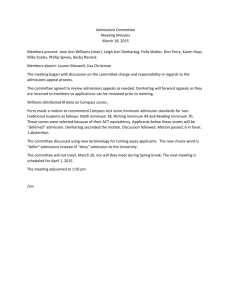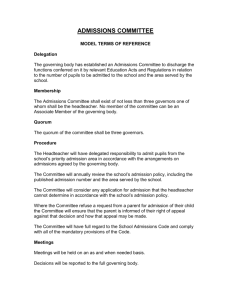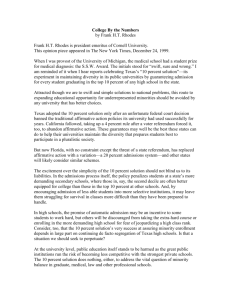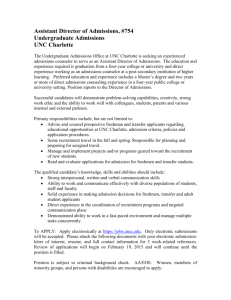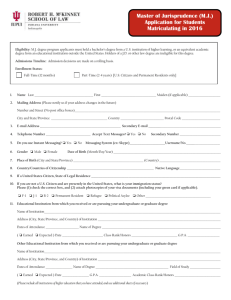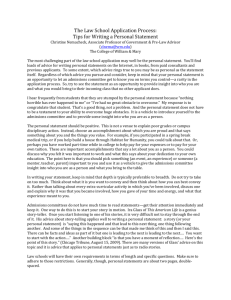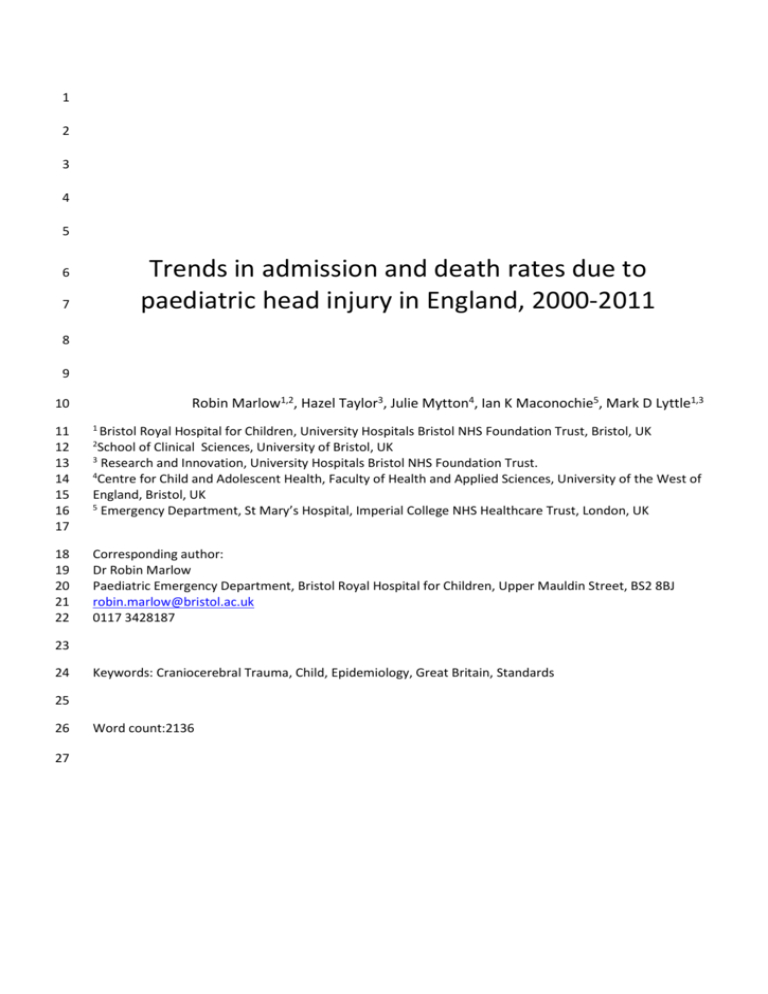
1
2
3
4
5
Trends in admission and death rates due to
paediatric head injury in England, 2000-2011
6
7
8
9
Robin Marlow1,2, Hazel Taylor3, Julie Mytton4, Ian K Maconochie5, Mark D Lyttle1,3
10
11
12
13
14
15
16
17
1
18
19
20
21
22
Corresponding author:
Dr Robin Marlow
Paediatric Emergency Department, Bristol Royal Hospital for Children, Upper Mauldin Street, BS2 8BJ
robin.marlow@bristol.ac.uk
0117 3428187
Bristol Royal Hospital for Children, University Hospitals Bristol NHS Foundation Trust, Bristol, UK
School of Clinical Sciences, University of Bristol, UK
3
Research and Innovation, University Hospitals Bristol NHS Foundation Trust.
4
Centre for Child and Adolescent Health, Faculty of Health and Applied Sciences, University of the West of
England, Bristol, UK
5
Emergency Department, St Mary’s Hospital, Imperial College NHS Healthcare Trust, London, UK
2
23
24
Keywords: Craniocerebral Trauma, Child, Epidemiology, Great Britain, Standards
25
26
27
Word count:2136
28
Abstract
29
Background
30
The number of children admitted to hospital is increasing year on year, with very short stay admissions
31
doubling in the last decade. Childhood head injury accounts for half a million Emergency Department
32
attendances in the UK every year. The National Institute for Health and Care Excellence has issued three
33
iterations of evidence-based national guidance for head injury since 2003.
34
Objectives
35
To assess if any changes in the rates of admission, death, or causes of head injury could be temporally
36
associated with the introduction of sequential national guidelines by longitudinal analysis of the
37
epidemiology of paediatric head injury admissions in England from 1st January 2000 to 31st December
38
2011.
39
Methods
40
Retrospective analysis of English Hospital Episode Statistics data of children under 16 years admitted to
41
hospital with the discharge diagnosis of head injury.
42
Results
43
The number of hospital admissions with paediatric head injury in England rose by 10% from 34150 in
44
2000 to 37430 in 2011, with the proportion admitted for less than one day rising from 38% to 57%. The
45
main cause of head injury was falls (42-47%). Deaths due to head injury decreased by 52% from 76 in
46
2000 to 40 in 2011. Road traffic accidents were the main cause of death in the year 2000 (67%) but fell to
47
40% by 2011. In 2000, children who were admitted or died from head injuries were more than twice as
48
likely to come from the most deprived compared to least deprived homes. By 2011 the disparity for risk
49
of admission had narrowed but no change was seen for risk of death.
50
Conclusions
51
Significant temporal relationships exist between implementation of the NICE2007 guidance and increased
52
admissions, shorter hospital stay and reduced mortality. The underlying cause of this association is likely
53
tobe multi-factorial.
54
INTRODUCTION
55
Over the last decade there has been an increase in childhood hospital admission rates in England, with a
56
pronounced rise in very short stay (less than one day) admissions for medical illnesses.[1] The causes are
57
not clear; re-organisation of primary care out-of-hours provision, introduction of emergency department
58
(ED) waiting time targets and changes in health seeking behaviour have all been suggested.[2] Head
59
injury is the commonest presentation of major and moderate paediatric trauma.[3] Although most have
60
no long term consequences, a proportion suffer traumatic brain injury (TBI),[4] which remains (?) the
61
leading potentially avoidable cause of death and chronic neuro-disability in childhood.[5]
62
Prompt identification and early intervention in serious TBI may prevent life-changing detrimental
63
outcomes. To detect such injuries cranial Computed Tomography (CT) is the gold standard investigation.
64
It identifies those who require neurosurgical intervention or other intensive therapy, and aids in
65
discharge decisions when normal. With technological advancement and increased availability, rates of CT
66
for childhood head injuries approached 50% in North America by 2003.[6] However the recognition that
67
radiation exposure from CT in childhood may reduce IQ[7] or increase the risk of later malignancy[8,9]
68
has driven research to identify which children are at sufficiently high risk of traumatic brain injury to
69
warrant CT.[4,6,10]
70
The National Institute for Health and Care Excellence (NICE) has produced three iterations of evidence-
71
based guidelines for the early management of children with head injury in 2003, 2007 and 2014,[11–13]
72
replacing advice from the Royal College of Surgeons (in 1984 and 1999).[14,15] A crucial component in all
73
versions has been guidance regarding imaging. The first NICE guideline was largely extrapolated from
74
adult studies due to limited paediatric-specific evidence. Many clinicians felt this led to unacceptably
75
high CT rates and used locally derived guidelines with higher thresholds and lower scan rates.[16,17] The
76
2007 revision incorporated criteria from a paediatric UK study;[4] with acceptable CT rates this became
77
widely used, though with some centres making minor modifications.[18] The most recent version (NICE
78
2014) introduced risk stratification, defining a cohort of children who may be actively observed rather
79
than progressing to immediate CT scan. This practice for selected patients has been shown to be
80
associated with approximately half the adjusted odds of performing CT and no increase in adverse
81
effects, leading to the suggestion that this approach could safely reduce CT rates.[19]
82
We aimed to determine whether mortality or admission rates from childhood head injury have changed
83
with successive iterations of NICE guidance, and to explore the epidemiology to identify any potentially
84
alternative influences.
85
86
METHODS
87
Data sources
88
Hospital Episode Statistics (HES) is a centrally collected anonymised record of all admissions to English
89
National Health Service hospitals. It uses nationally standardized coding systems to record diagnoses
90
(International Classification of Diseases - ICD10), procedures and operations (Office of Population
91
Censuses and Surveys - OPCS4). We used this dataset to identify all admissions during 1st January 2000-
92
31st December 2011 of children under 16 years at the time of admission given a coded diagnosis of head
93
injury (ICD10 codes S00-S09). We grouped the coded mechanism of injury into Road Traffic Injuries (V00-
94
V99), Falls (W00-W19), Struck by animate object (W20-W49), Struck by inanimate object (W50-64),
95
Assault (X85-Y09); Unrecorded and Others (all other coded causes of injury). We identified episodes with
96
neurosurgical interventions (OPCS4 codes A05, A40, A41, V03) or cranial imaging (OPCS4 code U051)
97
although CTs were not routinely recorded before 2006.
98
We used Office for National Statistics mid-year estimates of the English population as our denominator.
99
To evaluate association of socio-economic status with risk of avoidable injury, we identified the index of
100
multiple deprivation (IMD) decile for the household location of each head injury admission. The IMD
101
provides a relative measure of deprivation at small area level across England. Combining seven different
102
dimensions of deprivation, it ranks England into 32,482 areas from least to most deprived[20].
103
Data analysis.
104
To standardize between years, annual head injury admission, mortality, and neurosurgery rates were
105
calculated for the English population under the age of 16 as incidence rate ratios with 95% confidence
106
intervals, relative to the year 2000. For these outcomes a negative binomial regression model was fitted
107
and a test for a linear trend by year was carried out. We assessed guideline eras by assessing the last
108
three years of their use to allow for implementation delays. Between these periods, admission rates,
109
death rates and neurosurgery rates were compared by fitting a negative binomial regression model.
110
Logistic regression models were fitted in order to test for a linear trend by year for the proportion of
111
admissions being admitted for less than a day, one day, or two days or more. To analyse the effects of
112
socio-economic status, we fitted negative binomial models for admission and for death rates over the
113
twelve year period against IMD quintiles (using the least deprived as baseline) adjusting for quintile
114
population density to calculate incidence rate ratios. Data extraction and analysis were completed using
115
the statistical languages R[21] and Stata[22].
116
117
RESULTS
118
[Table 1 – Description of admissions and deaths due to head injury in children aged 0-15 years, 2000-2011]
119
Epidemiological Trends
120
Between 2000 and 2011 there was a statistically significant rise in admissions with head injury (Table 1)
121
from 34 to 37 per 10,000 children, whilst the number dying due to head injury fell significantly from 7.6 to
122
4.0 per million). There was no statistically significant trend in the neurosurgery rate (relative to the
123
population) (p=0.220). Of those admitted, the number admitted for a very short duration (less than 1
124
day) rose 20% from 37.6% in 2000 to 57.4% in 2011 (p<0.001 for linear trend). Correspondingly
125
admissions for one day fell by 14% and for two days or more (≥2) dropped by 6% (both p<0.001 for a
126
linear trend by year). Between 2006 and 2009 the proportion of admitted patients having a CT rose and
127
plateaued thereafter.
128
129
Guideline Eras
130
[Table 2 – Comparisons between guideline eras].
131
There was a statistically significant difference in admission rates between guideline eras (p = 0.0022).
132
Admission rates were higher in NICE 2003 compared to RCS. Admission rates were also higher in NICE
133
2007 compared to either NICE 2003 or RCS. There was a statistically significant difference in death rates
134
between guideline eras (p=0.006), with the death rates statistically significantly lower in NICE 2007
135
compared to either RCS or NICE 2003. Neurosurgery rates did not differ between guideline eras greater
136
than could have occurred by chance (p=0.1647). For those admitted, the proportion of less than one day
137
admissions rose significantly (p<0.001) between the guideline periods, and the proportion of longer
138
admissions (1 day or 2 days or more) dropped significantly (p<0.001).
139
Aetiology of admissions and deaths
140
Figure 1) Causes of head injury admission / year
141
The leading cause of head injuries requiring admission was falls (42-47%) with other causes remaining
142
constant (fig 1). The predominant cause of death (fig2) was road traffic accidents, reducing from 67% of
143
all head injury related deaths in 2000 to 40% in 2011 (p=0.01). Of fatal road traffic accidents, 65-100%
144
were pedestrians or cyclists.
145
Deprivation
146
Differences in admission and death rates exist between children from different socioeconomic quintiles.
147
One percent of records were missing socio-economic data, and were excluded from the analysis. In 2000
148
twice as many children from the most deprived quintiles were admitted (incidence rate ratio [IRR] 2.06
149
[95% CI 1.99-2.13]) and more than twice as many died (2.31 [95% CI 1.77- 3.02]) compared to those from
150
the least deprived quintile?. Less marked although still significant differences were seen comparing other
151
quintiles [table 3 & 4 online only]. Over the period studied the disparity in rates of admissions
Figure 2) Causes of head injury death / year
152
significantly reduced (p<0.001) across all levels of socioeconomic status. By 2011 when compared to the
153
highest quintile, the IRR of admission in the lowest quintile had fallen to 1.47[95% CI 1.43-1.52]. With
154
comparatively small numbers of deaths there was no statistically significant interaction between year and
155
deprivation quintile, suggesting that the relationship between death rates and deprivation quintile
156
remained similar across the years.
157
158
DISCUSSION
159
Between 2000 and 2011 rates of admission for childhood head injury rose. However within this overall
160
rise, we have demonstrated an increasing proportion of admissions lasting less than one day, and a
161
significant reduction in the overall number of bed days occupied. Over the same period there was a
162
reduction in mortality due to head injury, whilst the number of children requiring neurosurgical
163
intervention remained constant.
164
Previous analysis of HES data[23] demonstrated that after introduction of the NICE 2003 guideline,
165
admission rates for adults increased but children were unaffected. We have shown that following
166
implementation of the NICE 2007 guideline there was a statistically significant rise in the number of
167
admissions and fall in the number of deaths in the paediatric population. The clinical decision rule on
168
which NICE 2007 was based predicted a rise in rates of CT scanning from a baseline of 3.3% to just over
169
14% if fully implemented. It would be expected that full implementation of NICE 2007 guidance would
170
have resulted in increased CT rates, perhaps with an associated reduction in admissions and length of
171
stay. CT scanning and discharge direct from ED compared to admission for observation is a cost-saving
172
strategy. Using the NHS 2013 reference payment tariffs,[24] an ED attendance where the patient has a
173
CT scan and is discharged (VB03Z £242) costs one third the combined tariffs of an ED attendance and
174
admission for observation (£730 = VB04Z £228 + PR07B £502). If clinicians observe children for a short
175
period of time prior to a decision on the need for imaging (the approach now suggested in NICE 2014) we
176
may see yet further increasing admission rates and resulting costs.
177
The limitations of our study are mainly due to the nature of the routinely collected dataset. Our choice of
178
outcomes as “admission or death due to head injury” are pragmatic; we were not able to assess how
179
many children survived but had adverse neurological outcomes. Despite HES data being rigorously
180
collected using a strictly defined dataset, it is prone to external factors that may change over time. This
181
can be seen in the anomalous rise in numbers of CT scans following their introduction to the dataset in
182
2006. HES is the gold standard NHS activity dataset, extracted directly from hospitals’ reports to their
183
commissioners to claim payment; and estimated to capture 99.8% of all admissions[25]. It has been
184
postulated that introduction of ED quality indicators (especially the drive to spend no more than four
185
hours in an ED, first introduced in 2001) has caused the rising number of short term admissions. However
186
admission rates for children with medical complaints were already rising[2] prior to their introduction.
187
Neurosurgery rates have not significantly changed despite increasing admissions, suggesting that the
188
overall incidence of severe head injury in childhood has remained relatively constant. We believe that
189
these findings may therefore represent a change in clinician behaviour, with lower severity thresholds for
190
admission combined with shorter stays before discharge. An alternative hypothesis is that the
191
proportion of children being admitted has remained constant, but more children are being taken to ED
192
and so more are being admitted. HES data did not include information on ED attendances until 2007 and
193
we have therefore not been able to examine this further.
194
Our rates of inpatient mortality due to head injury combined with those for Wales over the same time
195
period (personal communication - NHS Wales Infomatics Service) closely approximate the Office for
196
National Statistics figures for total childhood deaths due to head injury in England and Wales.[26] This
197
suggests that most children who die from head injuries do so in hospital rather than at the scene of the
198
incident. The reduction in deaths due to road traffic accidents is likely to be due to a combination of
199
factors. Over this period there have been improvements in safety for car occupants (e.g. use of booster
200
seats, airbags). However, as the greatest reduction in road traffic deaths has been in pedestrians/cyclists,
201
it may be that the focus on hard hitting road safety campaigns has been beneficial, or that this reflects a
202
reduction in exposure to risk with less walking and cycling in children.
203
Although there has been improvement over time, the effects of deprivation are still alarming with
204
children dying of head injuries twice as likely to come from the most deprived neighbourhoods. The
205
recent RCPCH report “Why do Children Die”[5] identified injuries and social inequality as two of the
206
modifiable targets to improve the health of children in the UK.
207
CONCLUSION
208
These data provide an important snapshot of healthcare use for the commonest childhood injury with
209
significant change in outcomes and resource use over time. Admission rates have changed since the
210
introduction of national guidelines with more frequent, shorter admissions for the same rate of
211
neurosurgical events, indicating that admission rates may not provide a consistent proxy for severity of
212
injury. They also provide a useful measure against which to compare the effects of the NICE 2014 head
213
injury guidance and benchmark any future changes of emergency care provision.
214
215
ACKNOWLEDGEMENTS
216
Thanks to Dora Wood for comments on the manuscript and Anna Morris (NHS Wales Infomatics Service)
217
for tabulating Welsh paediatric head injury mortality data.
218
HES data provided to the University of Bristol by the Health and Social Care Information Centre under
219
data reuse agreement IC Ref: NIC-164132-C45WP, IG Ref: RU919. Copyright © 2013, re-used with the
220
permission of The Health and Social Care Information Centre. All rights reserved.
221
ONS: Adapted from data from the Office for National Statistics licensed under the Open Government
222
Licence v.1.0.
223
What is already known on this topic
224
225
226
227
228
steadily rising.
Between 2000 and 2011, the number of children admitted with head injuries rose significantly
and mortality halved.
231
232
Head injury is the commonest presentation of moderate and major paediatric trauma
What this study adds
229
230
Rates of attendances to Emergency Departments with minor medical problems have been
These changes can be correlated with the introduction of NICE 2007 guidance although may
represent longitudinal shift due to other factors.
Falls were the predominant cause of admission but road traffic accidents the main cause of death
233
COMPETING INTERESTS
234
none
235
AUTHOR CONTRIBUTIONS
236
RM conceived the study, obtained the data, undertook the analyses and wrote the first draft of the
237
manuscript. All authors critically reviewed and edited the manuscript.
238
FUNDING
239
Dr Marlow is funded by a University Hospitals Bristol NHS Foundation Trust Clinical PhD studentship
240
REFERENCES
241
242
1
Saxena S, Bottle A, Gilbert R, et al. Increasing Short-Stay Unplanned Hospital Admissions among Children in
England; Time Trends Analysis ’97–‘06. PLoS ONE 2009;4:e7484. doi:10.1371/journal.pone.0007484
243
244
245
2
Gill PJ, Goldacre MJ, Mant D, et al. Increase in emergency admissions to hospital for children aged under 15 in
England, 1999–2010: national database analysis. Arch Dis Child 2013;98:328–34. doi:10.1136/archdischild2012-302383
246
247
3
Bayreuther J, Wagener S, Woodford M, et al. Paediatric trauma: injury pattern and mortality in the UK. Arch Dis
Child - Educ Pract Ed 2009;94:37–41. doi:10.1136/adc.2007.132787
248
249
250
4
Dunning J, Daly JP, Lomas J-P, et al. Derivation of the children’s head injury algorithm for the prediction of
important clinical events decision rule for head injury in children. Arch Dis Child 2006;91:885–91.
doi:10.1136/adc.2005.083980
251
252
253
5
Wolfe I, Macfarlane A, Donkin A, et al. Why children die: death in infants, children and young people in the UK
Part A. Published Online First: 2014.http://www.ncb.org.uk/media/1130496/rcpch_ncb_may_2014__why_children_die__part_a.pdf (accessed 27 Nov2014).
254
255
256
6
Kuppermann N, Holmes JF, Dayan PS, et al. Identification of children at very low risk of clinically-important
brain injuries after head trauma: a prospective cohort study. The Lancet 2009;374:1160–70.
doi:10.1016/S0140-6736(09)61558-0
257
258
7
Hall P, Adami H-O, Trichopoulos D, et al. Effect of low doses of ionising radiation in infancy on cognitive
function in adulthood: Swedish population based cohort study. Bmj 2004;328:19.
259
260
261
8
Pearce MS, Salotti JA, Little MP, et al. Radiation exposure from CT scans in childhood and subsequent risk of
leukaemia and brain tumours: a retrospective cohort study. The Lancet 4;380:499–505. doi:10.1016/S01406736(12)60815-0
262
263
264
9
Mathews JD, Forsythe AV, Brady Z, et al. Cancer risk in 680 000 people exposed to computed tomography scans
in childhood or adolescence: data linkage study of 11 million Australians. BMJ 2013;346:f2360–f2360.
doi:10.1136/bmj.f2360
265
266
10 Osmond MH, Klassen TP, Wells GA, et al. CATCH: a clinical decision rule for the use of computed tomography in
children with minor head injury. Can Med Assoc J 2010;182:341–8. doi:10.1503/cmaj.091421
267
268
11 National Institute for Clinical Excellence. Head injury: triage, assessment, investigation and early management
of head injury in infants, children and adults. London: : National Institute for Clinical Excellence 2003.
269
270
271
12 National Institute for Health and Clinical Excellence. Head injury triage, assessment, investigation, and early
management of head injury in infants, children, and adults. London: : National Collaborating Centre for Acute
Care 2007.
272
273
274
13 National Institute for Health and Care Excellence. Head injury: Triage, assessment, investigation and early
management of head injury in children, young people and adults. London: 2014.
http://www.nice.org.uk/guidance/CG176 (accessed 29 Jul2014).
275
276
14 Guidelines for initial management after head injury in adults. Suggestions from a group of neurosurgeons. Br
Med J Clin Res Ed 1984;288:983–5.
277
278
279
280
15 The Royal College of Surgeons of England. Report of the Working Party on the Management of Patients with
Head Injuries.
1999.https://www.rcseng.ac.uk/publications/docs/report_head_injuries.html/@@download/pdffile/Managem
ent.pdf (accessed 13 Jul2014).
281
282
16 Willis AP, Latif SAA, Chandratre S, et al. Not a NICE CT protocol for the acutely head injured child. Clin Radiol
2008;63:165–9. doi:10.1016/j.crad.2007.05.027
283
284
17 Macgregor DM, McKie L. CT or not CT--that is the question. Whether ’tis better to evaluate clinically and x ray
than to undertake a CT head scan! Emerg Med J EMJ 2005;22:541–3. doi:10.1136/emj.2004.017160
285
286
18 Goodacre SW, Pandor A, Pickering A. Management of isolated minor head injury in the UK. Emerg Med J
2010;27:856–9. doi:10.1136/emj.2009.086389
287
288
19 Nigrovic LE, Schunk JE, Foerster A, et al. The Effect of Observation on Cranial Computed Tomography Utilization
for Children After Blunt Head Trauma. Pediatrics 2011;127:1067–73. doi:10.1542/peds.2010-3373
289
290
20 OpenDataCommunities - Deprivation Mapper. http://opendatacommunities.org/showcase/deprivation
(accessed 16 Jun2015).
291
292
21 R Core Team. R: A Language and Environment for Statistical Computing. Vienna, Austria: : R Foundation for
Statistical Computing 2014. http://www.R-project.org/
293
22 StataCorp. Stata Statistical Software: Release 12. College Station, TX. 2011.
294
295
23 Goodacre S. Hospital admissions with head injury following publication of NICE guidance. Emerg Med J
2008;25:556–7. doi:10.1136/emj.2007.055723
296
297
24 NHS reference costs 2013 to 2014 - Publications - GOV.UK. https://www.gov.uk/government/publications/nhsreference-costs-2013-to-2014 (accessed 29 Jan2015).
298
299
300
25 Health and Social Care Information Centre. Hospital Episode Statistics, Admitted Patient Care - England, 201112 - Data Quality. 2011.http://www.hscic.gov.uk/catalogue/PUB08288/hosp-epis-stat-admi-pati-care-eng-1112-qual.pdf
301
302
303
26 Mortality Statistics: Deaths registered in England and Wales (Series DR). Off. Natl. Stat.
http://www.ons.gov.uk/ons/rel/vsob1/mortality-statistics--deaths-registered-in-england-and-wales--series-dr/index.html (accessed 1 Dec2014).
304
305
306
Table 1 – Description of admissions and deaths due to head injury in children aged 0-15 years, 2000-2011
Guideline
Year
Number of HI
Admissions
Incidence rate ratio
of admission
compared to 2000
(95% CI)
Number of HI deaths
Incidence rate ratio
of death compared to
2000 (95% CI)
Number of
neurosurgeries
Incidence rate ratio
of neurosurgery
compared to 2000
(95% CI)
% admissions having
a CT scan
% admissions with
length of stay <1 day
% admissions with
length of stay =1 day
% admissions with
length of stay ≥2
days
307
2000
RCS[15]
2001
2002
2003
NICE 2003
2004
2005
2006
2007
2008
NICE 2007
2009
2010
34150
34754
32704
33842
34291
35002
34844
33248
33331
35679
36360
37430
1.00
1.03
(1.011.04)
0.97
(0.950.98)
1.00
(0.991.02)
1.02
(1.011.04)
1.04
(1.031.06)
1.04
(1.021.05)
0.99
(0.981.01)
0.99
(0.971.00)
1.05
(1.041.07)
1.07
(1.051.08)
1.09
(1.081.11)
76
63
59
62
60
42
59
35
35
30
26
40
1.00
0.83
(0.601.17)
0.79
(0.561.10)
0.83
(0.591.16)
0.80
(0.571.13)
0.56
(0.390.82)
0.79
(0.561.11)
0.47
(0.310.70)
0.47
(0.310.70)
0.40
(0.260.61)
0.34
(0.220.54)
0.52
(0.360.77)
147
127
107
144
127
153
143
116
119
134
117
119
1.00
0.87
(0.691.10)
0.74
(0.570.94)
0.99
(0.791.25)
0.88
(0.691.11)
1.06
(0.841.33)
0.99
(0.791.25)
0.80
(0.631.02)
0.82
(0.641.04)
0.92
(0.731.16)
0.80
(0.631.02)
0.81
(0.631.03)
-
-
-
-
-
-
*6.2
*12.0
14.5
16.4
16.3
16.1
37.6
39.6
40.8
41.9
44.7
47.4
50.0
51.2
53.5
55.0
56.4
57.4
47.9
46.5
45.1
45.1
43.6
41
39.2
38.1
36.5
35.1
34
33.8
14.4
13.9
14.1
13.1
11.7
11.5
10.8
10.7
9.9
9.9
9.6
8.8
* CT data was not routinely collected prior to 2006, data for 2006 and 2007 may be incomplete
308
309
Table 2 – Comparisons between guideline eras*.
Guideline
Period averaged over
Mean number of admissions per year
<16yrs
IRR for the admission rate (95% CI)
Mean number of deaths <16 years
IRR for the death rate (95% CI)
Mean number of admissions with
neurosurgery per year
IRR for the neurosurgery rates (95% CI)
Proportion of admissions with a length of
stay of <1 day
310
311
2011
RCS
2000-2002*
NICE 2003
2004-2006*
NICE 2007
2009-2011*
33668
34891
36105
1.00
66
1.00
1.04 (1.01-1.06)
54
0.82 (0.67-1.01)
1.07 (1.04-1.10)
32
0.48 (0.38-0.62)
126
142
122
1.00
1.12 (0.97-1.30)
0.97 (0.83-1.12)
39.3%
47.4%
56.3%
*comparing the last three years of a guidelines use to allow for implementation delays.
312
Deprivation
Quintile
Least deprived
0-20%
less deprived
20-40%
Median
Deprived
40-60%
More deprived
60-80%
Most deprived
80-100%
313
314
Table 3 – Incidence rate ratios of admissions by year and socioeconomic quintile.
2000
2001
2002
2003
2004
2005
IRR [95% CI}
2006
2007
2008
2009
1.00
1.00
1.00
1.00
1.00
1.00
1.00
1.00
1.00
1.00
1.16
(1.12,1.21)
1.32
(1.27,1.37)
1.05
(1.01,1.09
1.20
(1.16,1.25)
1.09
(1.05-1.13)
1.18
(1.13,1.22)
1.13
(1.09-1.17)
1.22
(1.17-1.27)
1.10
(1.06-1.14)
1.24
(1.20-1.29)
1.13
(1.09. 1.18)
1.25
(1.21-1.30)
1.14
(1.10-1.18)
1.24
(1.19-1.28)
1.08
(1.04,1.12)
1.21
(1.16,1.25)
1.08
(1.04-1.12)
1.18
(1.14-1.22)
1.07
(1.03-1.11
1.13
(1.09-1.17
1.57
(1.51,1.63)
2.06
(1.99,2.13)
1.42
(1.37,1.47)
1.84
(1.78-1.91)
1.39
(1.34,1.44)
1.79
(1.72-1.85)
1.47
(1.42-1.53)
1.87
(1.81-1.94)
1.42
(1.37-1.47)
1.79
(1.73-1.85)
1.45
(1.40-1.50)
1.77
(1.72,1.83)
1.45
(1.40-1.50)
1.86
(1.80-1.92)
1.34
(1.30-1.39)
1.73
(1.68-1.79)
1.39
(1.34-1.44)
1.71
(1.65-1.77)
1.30
(1.26-1.35
1.58
(1.53-1.63
This shows how risk of admission for the population under the age of 16 vary by year and by
socioeconomic quintile as measured by the index of multiple deprivations.
315
316
Table 4 – Incidence rate ratios of deaths by socioeconomic status quintile.
Deprivation Quintile
Least deprived
0-20%
less deprived 20-40%
Median Deprived
40-60%
More deprived
60-80%
Most deprived
80-100%
317
318
319
320
IRR (95% CI)
1.00 (Reference)
1.26 (0.92-1.72)
1.26 (0.92-1.72)
1.60 (1.19-2.15)
2.31 (1.77-3.02)
This shows how risk of death for the population under the age of 16 vary by socioeconomic quintile as
measured by the index of multiple deprivations. There was no significant interaction with risk of death by
year.

